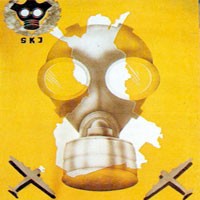This post is reprinted from an article I wrote in Sept 2013

Posters go to war. The Finnish Propaganda Posters are actually some of the more comical ones. The posters depicted the doctor’s healing wounds, chefs preparing meals, cigars to smoke, and vodka that was plentiful. Commodities Russians were craving & being denied because of the war. These things (and much more) were promised if they would only surrender to the Finnish. Right! It is pretty insulting, yet funny in a twisted sort of way. That they would actually buy into that.
War
We just finished an article on Soviet Propaganda Posters, however it was centered around travel to the USSR circa 1935-1943. But, around this same time period The Soviets were at War with Finland. This would be called the “Winter War” (1939-1940) and the “Continuation War” (1941-1944).
The Finnish obviously had other plans for poster making. This time period was in the middle of World War Two (in case you haven’t guessed that yet). Finland has a deep history (albeit not a good one ) with Russia and Germany. In a nutshell, Finland was seized from Sweden in 1809 by The Russian Empire. After a civil war (1914) the new government was supported by Germany.
As you have probably deduced (after many turn of events) Finland would align itself with the Germans in World War II. However, They would never be indoctrinated into the Nazi Party and never swayed from their own doctrine, democratic government or military structure. The war with The Soviet Union is what was important to Finland.
Propaganda Posters
It seems the word that worked for everybody in this decade of war was propaganda! It means: influencing the masses with a one sided story largely through repetition. I’ve now seen propaganda as early as 1809 in a painting “Napoleon Crossing the Alps”. There were 5 versions done and all are preserved in museums today. – but, i digress.
Through the first quarter of the 20th Century, posters were being created with different purposes in mind and varying degrees of positive or negative influence. Some of the earliest posters I see are actually British Safety Posters. Starting in about 1916 with urging pedestrians to walk facing traffic. It was hugely successful and saved many lives. The total opposite degree would be Finnish Propaganda Posters urging soldiers to drop their weapons and surrender. Finland was, by far, not producing the only war propaganda posters. They were published by everyone (including America) because it worked and motivated people in the war effort. This difference (of course) is how helpful or destructive these messages were.
More Helpful Posters
The next wave of posters (unrelated to war) could have been the Soviet travel posters in 1929. This program showed the USSR as some kind of Shangri-La / Riviera type of leisure get away. While totally deceitful, they had a bright, cheery, happy and attractive feel to them, at least.
I did want to mention The American WPA Poster Program hatched from Roosevelt’s “New Deal”. While these came a little bit later, they were still very helpful posters to Americans. Although the messages being sent on ethics, good hygiene, bridge openings, parks and recreations and current events could be considered mild propaganda. It was receptive and helped put allot of people back to work including artists.
The bottom line is the vintage community posters, Finnish propaganda posters (featured here) or travel posters from Russia had a purpose and target market. They were made to motivate, persuade, and influence the masses. Usually for political gain, national solidarity, or economic rationale.
